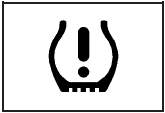Tire Pressure Monitor Operation
This vehicle may have a Tire Pressure Monitor System (TPMS). The TPMS is designed to warn the driver when a low tire pressure condition exists. TPMS sensors are mounted onto each tire and wheel assembly, excluding the spare tire and wheel assembly. The TPMS sensors monitor the air pressure in the vehicle’s tires and transmits the tire pressure readings to a receiver located in the vehicle.

When a low tire pressure condition is detected, the TPMS illuminates the low tire pressure warning light located on the instrument panel cluster.
At the same time a message to check the pressure in a specific tire appears on the Driver Information Center (DIC) display. The low tire pressure warning light and the DIC warning message come on at each ignition cycle until the tires are inflated to the correct inflation pressure. Using the DIC, tire pressure levels can be viewed by the driver. For additional information and details about the DIC operation and displays see DIC Operation and Displays and DIC Warnings and Messages.
The low tire pressure warning light may come on in cool weather when the vehicle is first started, and then turn off as you start to drive. This could be an early indicator that the air pressure in the tire(s) are getting low and need to be inflated to the proper pressure.
A Tire and Loading Information label, attached to your vehicle, shows the size of your vehicle’s original equipment tires and the correct inflation pressure for your vehicle’s tires when they are cold. See Loading the Vehicle, for an example of the Tire and Loading Information label and its location on your vehicle. Also see Inflation - Tire Pressure.
Your vehicle’s TPMS can warn you about a low tire pressure condition but it does not replace normal tire maintenance. See Tire Inspection and Rotation and Tires.
Notice: Using non-approved tire sealants could damage the Tire Pressure Monitor System (TPMS) sensors. TPMS sensor damage caused by using an incorrect tire sealant is not covered by the vehicle warranty. Always use the GM approved tire sealant available through your dealer/retailer.
Factory-installed Tire Inflator Kits use a GM approved liquid tire sealant. Using non-approved tire sealants could damage the TPMS sensors. See Tire Sealant and Compressor Kit for information regarding the inflator kit materials and instructions.
See also:
Automatic Transmission
The automatic transmission has a shift lever located on the console between the seats.
The mode or selected gear is shown in the instrument cluster
P (Park): This position locks the drive wheels ...
Shifting Into Park
WARNING!
It can be dangerous to get out of
the vehicle if the shift lever is not
fully in P (Park) with the parking
brake firmly set. The vehicle can
roll. If you have left the engine
runni ...
Cooling System
When you decide it is safe to lift the hood, here is
what you will see:
A. Coolant Recovery Tank
B. Radiator Pressure Cap
C. Engine Fan
A. Coolant Recovery Tank
B. Radiator Pressure Cap
C. ...


